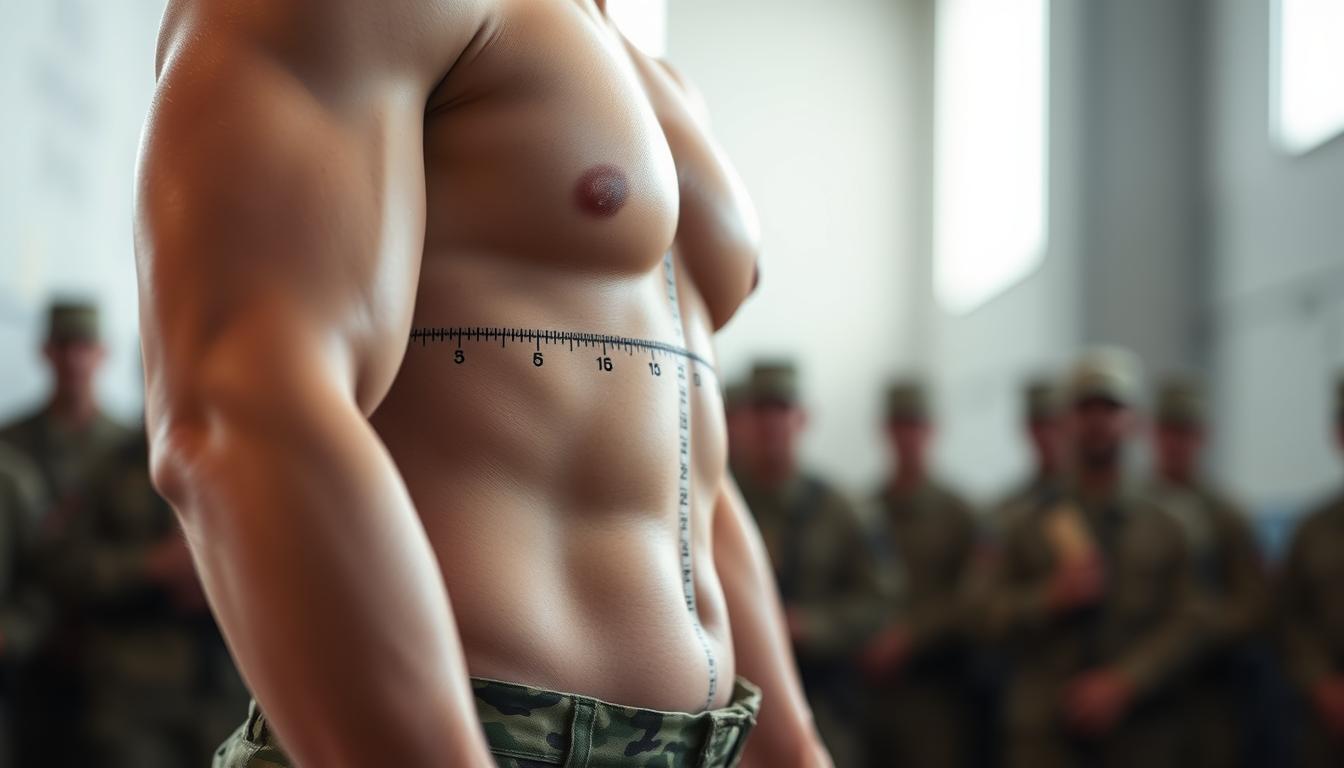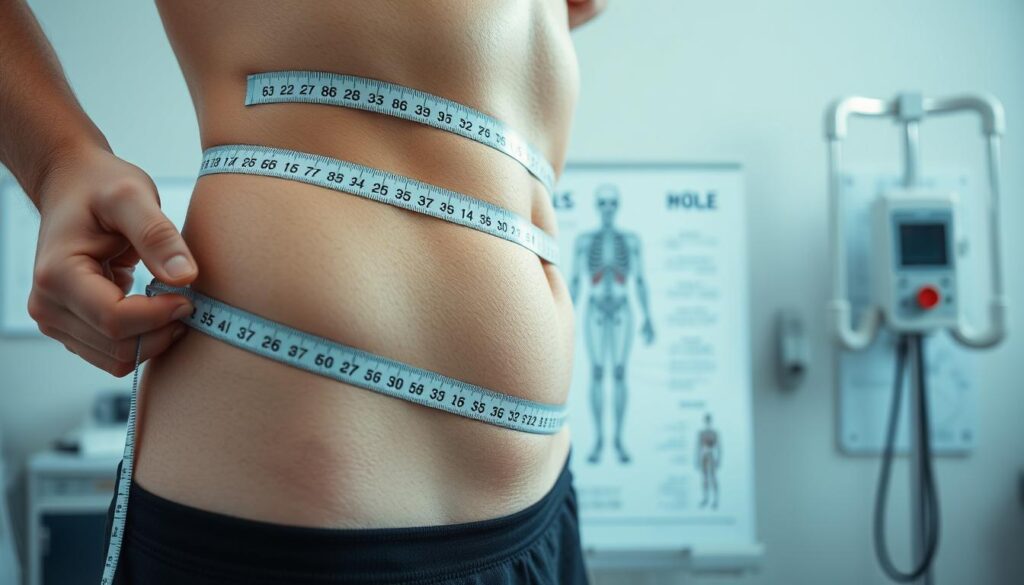What if a half-inch difference in your waistline could determine your career readiness? Military fitness standards leave no room for guesswork. Our guide breaks down the precise system behind body composition evaluations used by U.S. armed forces professionals.
Updated guidelines from June 12, 2023, require three specific measurements for assessing physical readiness. These metrics determine whether service members meet the strict requirements outlined in Department of Defense publications. Every pound and half-inch matters when calculating results through this standardized method.
We’ll show you why proper technique matters more than you might think. Tape measurements follow rounding rules that could mean the difference between passing or failing an assessment. Unlike civilian health tools, this system prioritizes consistency across thousands of evaluations.
Key Takeaways
- Three measurements determine fitness status: height, weight, and abdominal circumference
- Measurements round to nearest pound (weight) and 0.5 inch (tape)
- 2023 updates refine compliance with AR 600-9 standards
- Consistent technique prevents evaluation discrepancies
- Proper tool usage ensures career readiness
Understanding Army Body Composition and Measurement Guidelines
Physical readiness extends beyond endurance tests – it starts with precise body metrics. The U.S. military employs strict composition guidelines to ensure operational effectiveness and long-term health. Let’s explore how these standards work and why millimeter-level precision matters.
Body Fat Thresholds by Demographic
Service members must meet different body fat percentages based on age and gender. Women generally have higher allowable limits due to biological differences in fat distribution. Here’s the breakdown:
| Age Group | Male Max % | Female Max % |
|---|---|---|
| 17-20 | 20% | 30% |
| 21-27 | 22% | 32% |
| 28-39 | 24% | 34% |
| 40+ | 26% | 36% |
Why Measurement Precision Matters
Three factors determine assessment outcomes:
- Neck circumference: Measured below the larynx with tape parallel to the floor
- Waist measurement: Taken at the narrowest point above the navel
- Height verification: Recorded without shoes against a stadiometer
Using non-stretchable tape prevents underreporting measurements by up to 1.5 inches. Our quick tool for military fitness standards follows these exact protocols to generate reliable results.
Repeated measurements ensure consistency – AR 600-9 requires three separate readings for each body part. Proper technique directly impacts performance metrics like the ACFT score, creating fair evaluations across all service branches.
Mastering the Measurement Process for Accurate Results
Ever wonder why two people with similar stats get different fitness evaluations? The secret lies in measurement protocols. Military-grade precision requires more than casual checks – it demands systematic execution at every step.
Proper Height and Weight Measurement Techniques
Start with bare feet on a flat surface. Stand straight against a wall-mounted stadiometer, heels together. Breathe normally while your partner lowers the headboard gently. Record to the nearest half-inch – no rounding up or down.
For weight, use a calibrated scale first thing in the morning. Remove heavy clothing and empty pockets. “Always take three consecutive readings,” advises the Army’s body composition program manual. Average them before rounding to the nearest whole pound.
Guidelines for Circumference and Tape Measurements
Fiberglass tapes outperform cloth ones by preventing stretch errors. Find the narrowest abdominal point above the navel. Keep the tape parallel to the floor without compressing skin. Take three separate measurements, rotating 45 degrees between each.
Neck readings require special care. Position the tape below the larynx, avoiding bulky muscles. Consistent tension matters – pull snug but not tight. These steps help estimate body fat levels more reliably than quick civilian methods.
“Measure twice, record once – that’s how we maintain fairness across all age groups.”
By mastering these techniques, you’ll get results matching professional evaluations. Whether preparing for service or personal goals, precision transforms guesswork into actionable data.
That Army HT WT Calculator is used for – what are its exact measurements?
Precision transforms raw numbers into career-defining data. Military body composition assessments rely on a sophisticated equation that converts tape measurements into actionable insights. Let’s explore how this system works and how to use it correctly.
Exploring the Formula and Accuracy
The Department of Defense-approved equation uses three key metrics: waist circumference, neck size, and height. Unlike basic BMI calculators, this formula applies logarithmic adjustments to account for body proportions. Men and women have different constants in the equation to reflect biological variations in fat distribution.
Recent studies show this method aligns closely with DXA scan results when measurements follow protocol. The Army’s formula has evolved through decades of anthropometric research, ensuring fair evaluations across diverse demographics.
Step-by-Step Guide to Inputting Your Measurements
Follow these steps for reliable results:
- Measure waist at the narrowest point above the navel
- Record neck circumference below the Adam’s apple
- Input height without shoes to the nearest half-inch
Double-check each entry against standards outlined in AR 600-9. Soldiers often improve accuracy by taking three consecutive measurements and using fiberglass tapes. Proper data entry prevents miscalculations that could affect career progression.
Remember, a 0.5-inch error in waist measurements can alter body fat percentage by 1-2 points. Consistent technique ensures your results mirror official evaluations, keeping you mission-ready and compliant with fitness requirements.
Conclusion
Proper measurement techniques form the backbone of military readiness. Our guide shows how millimeter-level precision impacts career trajectories. By following the outlined methods, service members ensure their fitness data reflects true capabilities.
Three core principles drive success: consistent technique, proper tool selection, and understanding the science behind evaluations. Every recorded inch and pound plays a critical role in maintaining standards. The body composition program thrives when individuals master these steps as part of their routine.
Long-term health benefits emerge from regular compliance. Soldiers who track progress using approved methods often see improved performance metrics. Reliable results come from respecting each step in the process – from scale calibration to tape positioning.
We encourage revisiting the detailed guidelines in previous sections. Keep fiberglass tapes and calibrated scales handy for routine checks. Embrace these practices to stay mission-ready and meet evolving fitness benchmarks.
Your next move? Apply these methods during your next assessment prep. Precision today builds a stronger tomorrow – one accurate measurement at a time.
FAQ
How does the Army body fat calculator determine fitness levels?
We use a specialized formula approved by the Department of Defense that combines height, weight, neck circumference, and waist measurements. This method estimates body fat percentage to ensure soldiers meet military readiness standards.
Which body parts do we measure for the Army tape test?
Our process requires precise circumference measurements around the neck and waist. For females, we also include hip measurements. Proper tape placement ensures consistency across all assessments.
Why does the military use different body fat calculations than civilian methods?
Our standards prioritize mission-specific physical requirements. The Army body composition program accounts for muscle distribution patterns unique to military training, unlike general population health metrics.
Can inaccurate measurements affect a soldier’s career progression?
Absolutely. We’ve seen how improper tape placement or slouching during height checks can skew results. Consistent measurement techniques protect both service members’ careers and unit readiness.
What tools do we recommend for self-checking body fat percentages?
While our official assessments require certified tools, many soldiers successfully use flexible fiberglass tapes and digital scales for personal tracking. Always measure at the same time daily for comparable results.
How often does the Army update its body composition standards?
We review guidelines periodically through the Army Body Composition Program. Changes reflect new health research and operational needs, but core principles of the tape test remain consistent for fair evaluation.


